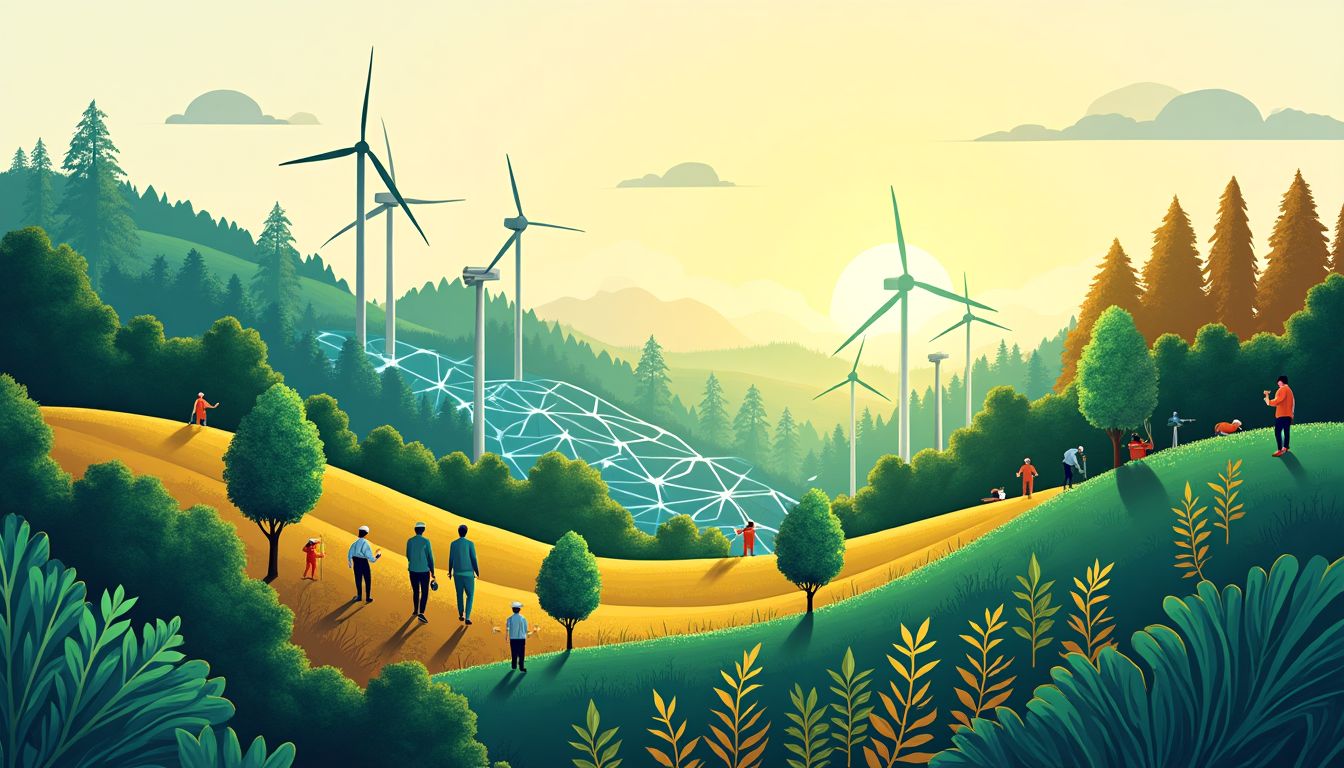What if the key to solving the climate crisis lies not in the hands of policymakers or activists alone, but in the algorithms of artificial intelligence? As the planet grapples with rising temperatures, melting ice caps, and increasingly erratic weather patterns, the need for innovative solutions has never been more urgent. Enter AI—a technology that, when wielded correctly, could revolutionize how we tackle climate change and ensure that the solutions are fair and inclusive for all.
Climate change is no longer a distant threat; it’s a present reality. From wildfires ravaging California to floods displacing millions in Bangladesh, the impacts are felt unevenly across the globe. Vulnerable communities, often the least responsible for greenhouse gas emissions, bear the brunt of the crisis. Traditional approaches—like carbon taxes or renewable energy mandates—have made strides, but they’re not enough. We need something smarter, faster, and more scalable. That’s where AI comes in.
Renowned thinkers like Fei-Fei Li, a pioneer in AI research, have long argued that technology can be a force for good. Similarly, climate scientist Katharine Hayhoe emphasizes the need for innovative tools to address the climate emergency. Even Yuval Noah Harari, the historian and author of Sapiens, has highlighted the transformative potential of AI in solving global challenges. Together, their insights paint a compelling picture: AI isn’t just a tool for tech giants—it’s a lifeline for a planet in peril.
This article explores how AI-led systems can optimize resource use, mitigate climate change, and promote global climate justice. From predicting extreme weather events to ensuring equitable access to clean energy, AI offers a roadmap to a sustainable future. But can it deliver on its promise? Let’s find out.
1. The Climate Crisis and the Need for Innovation
1.1 The Current State of Climate Change
The Earth is warming at an alarming rate. According to the Intergovernmental Panel on Climate Change (IPCC), global temperatures have already risen by 1.1°C since pre-industrial times. If we don’t act now, we could see a catastrophic 1.5°C increase by 2030. The consequences? More intense hurricanes, prolonged droughts, and rising sea levels that threaten coastal cities like Miami and Mumbai.
But the impacts aren’t evenly distributed. Marginalized communities—often in developing nations—are hit hardest. For example, in sub-Saharan Africa, where agriculture is the backbone of the economy, unpredictable weather patterns are devastating crops and livelihoods. Meanwhile, in the Arctic, Indigenous communities face the loss of their ancestral lands due to melting ice. This disparity is what we call climate injustice: those who contribute the least to the problem suffer the most.
1.2 Limitations of Traditional Approaches
Traditional climate solutions, while well-intentioned, have their limits. Take carbon taxes, for instance. While they incentivize companies to reduce emissions, they often fail to address the root causes of inequality. A factory in a wealthy nation might pay the tax and continue polluting, while a small farmer in a developing country struggles to adapt to changing weather patterns.
Renewable energy adoption is another example. While solar and wind power are growing rapidly, their deployment is uneven. Rural areas and low-income communities often lack the infrastructure to benefit from these technologies. Without a more inclusive approach, we risk leaving billions behind.
1.3 The Role of Technology in Climate Action
This is where technology, particularly AI, steps in. AI has already proven its worth in fields like healthcare, where it’s used to diagnose diseases faster than human doctors, and finance, where it predicts market trends with uncanny accuracy. Now, it’s time to apply that same ingenuity to climate action.
Imagine AI systems that predict hurricanes days in advance, giving communities time to prepare. Or algorithms that optimize energy grids, ensuring that renewable power reaches even the most remote villages. These aren’t just futuristic dreams—they’re real possibilities. Companies like Google DeepMind are already using AI to reduce energy consumption in data centers by up to 40%. If we can scale these solutions globally, the impact could be transformative.
But AI isn’t a silver bullet. It’s a tool—one that must be wielded carefully to avoid unintended consequences. As we explore its potential, we must also address the ethical challenges it poses. Only then can we harness its full power to create a sustainable and just future.
2. AI and Climate Justice: Bridging the Gap
2.1 Defining Climate Justice
Climate justice is about fairness. It’s the idea that everyone, no matter where they live or how much money they have, should have a fair shot at a healthy planet. But right now, the people who contribute the least to climate change—like those in low-income countries—are often the ones suffering the most. Think about it: a farmer in Bangladesh losing their land to rising sea levels, while a billionaire in New York City barely feels the effects. That’s not fair. AI can help fix this imbalance by making sure climate solutions are designed with equity in mind.
2.2 AI for Equitable Resource Distribution
Imagine a world where clean water, food, and energy are shared fairly. AI can make that happen. For example, in rural areas of India, AI-powered microgrids are already helping communities access reliable solar energy. These systems use machine learning to predict energy needs and distribute power efficiently. Similarly, AI is being used to optimize water distribution in drought-prone regions like California. By analyzing weather patterns and water usage data, AI can ensure that everyone gets their fair share—even in times of scarcity.
2.3 Empowering Vulnerable Communities
Vulnerable communities often lack the resources to prepare for or recover from climate disasters. AI can change that. For instance, in Kenya, AI-driven early warning systems are helping farmers predict droughts and plan accordingly. These systems analyze satellite data and weather patterns to provide accurate forecasts, giving people time to protect their crops and livelihoods. AI is also being used to build climate resilience in low-income countries. For example, the United Nations is using AI to map areas at risk of flooding and help communities prepare for extreme weather events.
3. AI-Driven Climate Mitigation Strategies
3.1 Optimizing Renewable Energy Systems
Renewable energy is key to fighting climate change, but it’s not always reliable. Solar panels don’t work at night, and wind turbines stop spinning when the air is still. AI can help solve these problems by optimizing renewable energy systems. For example, Google DeepMind has developed AI algorithms that predict wind power output 36 hours in advance, allowing energy grids to plan more effectively. Similarly, AI is being used to manage smart grids, which balance energy supply and demand in real time. This means less waste and more clean energy for everyone.
3.2 Reducing Carbon Footprints
AI can also help reduce carbon emissions in industries like transportation and manufacturing. For example, Tesla uses AI to optimize its electric vehicles’ energy use, making them more efficient and eco-friendly. In the shipping industry, AI is being used to plan more efficient routes, reducing fuel consumption and emissions. Even in factories, AI can monitor energy use and suggest ways to cut back. The result? A smaller carbon footprint and a healthier planet.
3.3 Sustainable Agriculture and Land Use
Agriculture is a major contributor to climate change, but AI can make it more sustainable. For example, AI-powered drones are being used to monitor soil health and crop growth, helping farmers use water and fertilizers more efficiently. In Brazil, AI is being used to combat deforestation by analyzing satellite images and detecting illegal logging activities. Projects like Global Forest Watch are using AI to track deforestation in real time, giving governments and activists the tools they need to protect the planet’s lungs.
Do not include the h1 tag. Do not include the outline title. Do not deviate from the outline in the tiniest bit and write in HTML using embedded links, ordered lists, unordered lists, tables, h2, h3 tags as needed.
4. Ethical Considerations and Challenges
4.1 Bias and Fairness in AI Systems
AI is not perfect. It learns from the data it’s fed, and if that data is biased, the results can be unfair. Take climate justice, for example. If AI systems are trained on data that ignores marginalized communities, they might end up favoring wealthier areas. That’s not just unfair—it’s counterproductive. Studies like the one from the MIT Technology Review show how biased AI can worsen existing inequalities.
So, how do we fix this? Here are some strategies:
- Diverse Data Collection: Include data from all communities, especially those most affected by climate change.
- Transparent Algorithms: Make sure the decision-making process of AI systems is clear and understandable.
- Community Involvement: Let local communities guide AI projects to ensure their needs are met.
4.2 Data Privacy and Security
AI thrives on data, but who owns that data? And who gets to use it? These are big questions when it comes to climate action. For instance, AI systems might collect data from weather sensors, satellites, or even personal devices. If this data isn’t handled carefully, it could be misused or leaked, putting people’s privacy at risk.
Here’s what we can do:
- Strong Data Governance: Governments and organizations need clear rules about how data is collected, stored, and shared.
- Anonymization: Remove personal information from datasets to protect identities.
- Public Consent: Involve communities in decisions about how their data is used.
Organizations like the World Wide Web Consortium (W3C) are already working on data privacy standards that could be applied to AI and climate projects.
4.3 Global Collaboration and Governance
Climate change is a global problem, and so is AI. That means we need global solutions. Right now, there’s no universal framework for how AI should be used in climate action. Some countries might use AI responsibly, while others might not. This lack of coordination could lead to uneven results or even conflicts.
Here’s how we can fix this:
- International Agreements: Countries need to work together on AI and climate policies, similar to the Paris Agreement.
- Shared Standards: Create global standards for AI ethics, data privacy, and climate action.
- Funding and Support: Wealthier nations should help developing countries build the infrastructure needed for AI-led climate solutions.
The United Nations and the IPCC (Intergovernmental Panel on Climate Change) could play a key role in bringing nations together to tackle these challenges.
5. Case Studies: AI in Action
5.1 AI for Disaster Prediction and Response
When disasters strike, every second counts. AI can help predict events like hurricanes, floods, and wildfires before they happen, giving people time to prepare. For example, IBM’s Watson has been used to analyze weather patterns and predict storms. Similarly, Google’s Crisis Response Team uses AI to map flood zones and guide evacuation efforts.
These systems save lives and reduce economic losses. In 2019, AI-driven flood predictions in India helped evacuate over 200,000 people, preventing countless casualties. That’s the power of AI in action.
5.2 AI in Urban Planning and Smart Cities
Cities are major contributors to climate change, but they can also be part of the solution. AI can help design smarter, more sustainable cities. For instance, Sidewalk Labs, a subsidiary of Alphabet, uses AI to optimize public transportation and reduce traffic congestion. In Singapore, AI is being used to manage energy use in buildings, cutting emissions by up to 30%.

6. AI Solutions: How Would AI Tackle This Issue?
6.1 Data Collection and Integration
The first step in leveraging AI for climate justice is gathering and integrating vast amounts of climate data. This includes satellite imagery, ground-based sensors, historical weather records, and even social media feeds. AI can clean, standardize, and analyze this data to provide actionable insights. For example, NASA and ESA already collect petabytes of Earth observation data, which AI can process to identify patterns and trends.
6.2 Predictive Modeling and Simulation
Once the data is collected, AI can create predictive models to forecast climate trends, extreme weather events, and resource availability. For instance, Google DeepMind has developed AI models that predict energy demand, optimizing the use of renewable energy sources. Similarly, AI can simulate the impact of various mitigation strategies, such as reforestation or renewable energy adoption, helping policymakers make informed decisions.
6.3 Optimization Algorithms
AI algorithms can optimize energy grids, transportation networks, and supply chains to reduce emissions and resource waste. For example, Tesla uses AI to optimize its electric vehicle batteries and energy storage solutions. These algorithms can be scaled and adapted to different regions, ensuring that solutions are both effective and equitable.
6.4 Community Engagement and Feedback Loops
AI can also gather input from local communities and incorporate their needs into climate solutions. For instance, Microsoft AI for Earth uses AI to engage with communities in developing countries, providing them with tools to monitor and manage their natural resources. Establishing feedback mechanisms ensures that AI systems continuously improve and remain aligned with community needs.
6.5 Implementation and Monitoring
Finally, AI-driven solutions can be deployed in pilot projects and monitored for effectiveness. For example, IBM Watson is used to track progress toward climate goals, adjusting strategies as needed. This ensures that AI systems are not only effective but also adaptable to changing conditions.
6.6 Scientific and Theoretical Foundations
AI's potential in climate science is backed by numerous studies and initiatives. For instance, IPCC reports highlight the role of AI in climate modeling. Additionally, advancements in quantum computing, such as those by IBM Quantum, promise to enhance AI capabilities, making climate models more accurate and comprehensive.
6.7 Action Schedule/Roadmap
Here’s a detailed roadmap for implementing AI-driven climate solutions:
- Day 0: Register domain: projectX123.com as a public-facing website and set up subdomains for scientists and academics as a data repository and community gathering spot.
- Day 1: Discuss and secure funding or assemble a group of experts to form a task force. Key stakeholders include MIT, Stanford, and IPCC.
- Day 2: Convene in Brussels to discuss initial strategies and secure political will. Invite representatives from the European Commission and United Nations.
- Week 1: Cluster computing power from OpenAI, Google DeepMind, and IBM Watson to begin data analysis.
- Week 2: Draft a white paper outlining the project’s goals, methodologies, and expected outcomes. Circulate among key stakeholders for feedback.
- Month 1: Establish pilot project guidelines and initiate the development or construction of physical prototypes. Focus on renewable energy optimization and disaster prediction systems.
- Month 2: Consolidate political will for the mission by presenting initial findings to global leaders at the UNFCCC conference.
- Month 3: Secure lab and plant space to host experimentation at MIT and other leading institutions.
- Year 1: Scale successful pilots globally, focusing on vulnerable regions. Implement AI-driven solutions in urban planning, agriculture, and energy systems.
- Year 1.5: Establish international governance frameworks for AI and climate justice, involving organizations like the United Nations and IPCC.
- Year 2: Achieve measurable reductions in emissions and resource waste through AI systems. Monitor progress and adjust strategies as needed.
AI and Climate Justice: A Vision for the Future
As we stand at the crossroads of technological innovation and environmental crisis, AI offers a beacon of hope. By optimizing resource use, predicting environmental changes, and empowering communities, AI can help create a sustainable and just future. The urgency to act has never been greater, and the tools at our disposal have never been more powerful.
Imagine a world where AI-driven systems ensure that no community is left behind in the fight against climate change. Where renewable energy is optimized to its fullest potential, and where vulnerable populations are equipped with the tools to adapt and thrive. This vision is not just a dream—it’s a possibility within our grasp.
But realizing this vision requires collaboration. Governments, corporations, and individuals must come together to harness the power of AI for climate justice. The time to act is now. Let’s embrace AI as a tool for positive change and ensure a livable planet for future generations.
What role will you play in this transformative journey? How can we ensure that AI-driven solutions are equitable and inclusive? Share your thoughts in the comments below and join the conversation. Together, we can turn the tide on climate change and build a brighter, more sustainable future.
Don’t forget to subscribe to our newsletter and become a permanent resident of iNthacity: the "Shining City on the Web". Like, share, and participate in the debate. The future is in our hands—let’s make it count.
FAQ
Q1: How can AI address climate injustice?
AI can help tackle climate injustice by making sure resources like water, food, and energy are shared fairly. For example, AI can predict where extreme weather will hit hardest and help communities prepare. It can also optimize renewable energy systems, like solar and wind power, to make sure even remote or underserved areas have access to clean energy. Projects like Microsoft’s AI for Earth are already using AI to solve environmental challenges in ways that benefit everyone, not just the wealthy.
Q2: What are the risks of using AI in climate action?
While AI has huge potential, it’s not without risks. One big concern is algorithmic bias, where AI systems might favor certain groups over others. For example, if an AI system is trained on data from wealthier areas, it might not work as well for poorer communities. There’s also the issue of data privacy—AI needs a lot of data to work, and that data often comes from people. Making sure this data is used ethically is crucial. Finally, we need strong global rules to make sure AI is used fairly and doesn’t create new inequalities.
Q3: Can AI really make a difference in combating climate change?
Absolutely! AI is already making a difference in many areas. For example:
- Renewable Energy: AI helps optimize wind and solar power systems, making them more efficient. Companies like Tesla are using AI to improve energy storage and distribution.
- Disaster Prediction: AI can predict hurricanes, floods, and wildfires, giving people time to prepare. Organizations like NASA use AI to analyze climate data and improve forecasts.
- Sustainable Farming: AI helps farmers use water and fertilizer more efficiently, reducing waste and protecting the environment.
These are just a few examples of how AI is already helping fight climate change.
Q4: How can I get involved in AI and climate justice initiatives?
There are many ways to get involved! Here are a few ideas:
- Support Organizations: Donate to or volunteer with groups like Greenpeace or WWF that are working on climate justice and using AI in their projects.
- Advocate for Change: Push for policies that promote ethical AI and climate action. Write to your local representatives or join campaigns by groups like 350.org.
- Stay Informed: Follow organizations like the IPCC or universities like Stanford and MIT, which are leaders in AI and climate research.
Q5: What are some real-world examples of AI helping with climate justice?
Here are a few inspiring examples:
- AI for Disaster Relief: After Hurricane Harvey, AI was used to analyze satellite images and identify the hardest-hit areas, helping relief teams prioritize their efforts.
- AI in Agriculture: In India, AI-powered tools are helping small farmers predict weather patterns and improve crop yields, reducing poverty and food insecurity.
- AI for Conservation: Organizations like Wildlabs use AI to track endangered species and stop illegal poaching.
Q6: What’s the role of big tech companies in AI and climate justice?
Big tech companies have a huge role to play. For example:
- Google: Through its AI for Social Good program, Google is using AI to tackle climate change, from predicting floods to protecting forests.
- Microsoft: Microsoft’s AI for Earth initiative funds projects that use AI to address environmental challenges.
- IBM: IBM’s Watson AI is being used to optimize energy use in cities and reduce carbon footprints.
These companies have the resources and expertise to make a big impact, but they also need to be held accountable to ensure their efforts are fair and inclusive.
Q7: How can AI help with climate education and awareness?
AI can make climate science more accessible to everyone. For example:
- Interactive Tools: AI-powered apps can help people understand their carbon footprint and suggest ways to reduce it.
- Personalized Learning: AI can create customized learning experiences, making it easier for people to understand complex climate issues.
- Data Visualization: AI can turn raw climate data into easy-to-understand visuals, helping people see the impact of climate change in real-time.
By making climate science more engaging and relatable, AI can inspire more people to take action.
Q8: What’s the biggest challenge in using AI for climate justice?
The biggest challenge is making sure AI benefits everyone, not just a few. This means:
- Ensuring Equity: AI systems need to be designed with input from diverse communities to avoid bias and ensure fairness.
- Global Collaboration: Climate change is a global problem, so AI solutions need to work across borders and cultures.
- Ethical Use of Data: We need strong rules to protect people’s privacy and make sure their data isn’t misused.
Overcoming these challenges will require teamwork from governments, companies, and individuals around the world.
Q9: Can AI help with climate policy-making?
Yes! AI can analyze huge amounts of data to help policymakers make better decisions. For example:
- Predicting Outcomes: AI can simulate the effects of different policies, like carbon taxes or renewable energy incentives, to see which ones work best.
- Identifying Trends: AI can spot patterns in climate data, helping policymakers understand where to focus their efforts.
- Engaging the Public: AI can analyze public opinion on climate issues, helping policymakers craft messages that resonate with people.
By providing data-driven insights, AI can make climate policy more effective and inclusive.
Q10: What’s next for AI and climate justice?
The future is full of possibilities! Here’s what we can look forward to:
- Better Predictions: As AI gets smarter, it will be able to predict climate events with even greater accuracy, saving lives and reducing damage.
- More Inclusive Solutions: AI will help us design climate solutions that work for everyone, no matter where they live or how much money they have.
- Global Collaboration: With AI, we can create a global network of climate action, where countries and communities work together to solve the crisis.
The key is to keep pushing for innovation and making sure AI is used ethically and equitably. Together, we can create a brighter, more sustainable future.
Disclaimer: This article may contain affiliate links. If you click on these links and make a purchase, we may receive a commission at no additional cost to you. Our recommendations and reviews are always independent and objective, aiming to provide you with the best information and resources.
Get Exclusive Stories, Photos, Art & Offers - Subscribe Today!



























Post Comment
You must be logged in to post a comment.